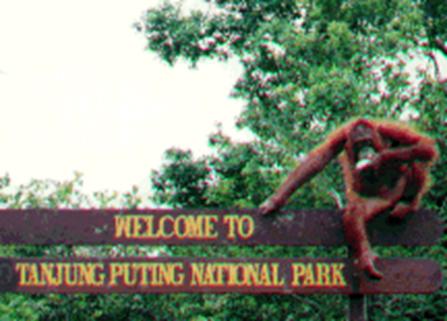Kumai River 02:44:58S 111:43:87E

|
After a long (480nm) passage from Bali, we arrived off the
mouth of the There were also a number of hazards that kept us on our toes
on this passage. Firstly the fishing boats and squid boats. There were so many
of them at night, that the radar screen looked like it had caught Measles! Just
covered in red dots. The squid boats are easy to spot, because they have
powerful lights shining into the water to attract the squid. But no navigation
lights (as with all the other FV), so extremely difficult to work out where
they are going or ifs they are stationary. I did discover in the end that
if you held your course they would get out of the way. But it was a bit like
playing “chicken” in the dark. Not the most relaxing of pastimes! Thunderstorms were the next form of entertainment (or
torture depending on your point of view). These would rage throughout the
night, and the lightening was everywhere. One of the BWR boats had come
here a week before us, and they had a near lightening strike, that took our
their whole navigation and radar systems. Not ideal! The next and new experience for us were the tugs and barges.
Fortunately we had received an e-mail from Dorothy on
This particular barge was loaded to the gunnels and beyond
with coal. It was between 400 and 500 metres behind the tug. Whilst the tug did
sport the correct navigation lights (three white lights in a vertical stack, as
well as the normal nav' lights, the barge had no lights at all. So in the
dark you have no way of knowing where the barge is.!! This is because the
wind and tide mean that it is never in a direct line behind the tug. We actually
saw one running parallel with it’s tug in the Kumai river during a
thunderstorm. Another of the BWR boats (who for decencies sake I will not name)
did run into one of these barges in the dark, and sustained some damage. They
now have a rather flattened anchor……… We were to find lots of these tugs and barge combinations
from now on whenever on passage. In The final hazard were floating fishing nets. As we
approached the mouth of the Kumai river at around 0500 in the morning the inevitable
happened. WE ran into a fishing net, that was about a mile long. WE were
travelling along at about 6 knots at the time. The boat just stopped dead after
a 100 metres or so after we hit the net. So we quickly went into neutral and
then after some tricky work with the bow thrusters, managed to extract
ourselves. Phew!! The journey up the river is a bit tortuous, but Per from Pelle
V had e-mailed us his waypoints and that made t a lot easier. As we travelled
along, we were hit by a monster thunderstorm, which stay with us right up to
the anchorage. Which was a shame, because it made taking pictures a little
pointless.
The town itself is something of an architectural car crash!
The skyline is dominated by large square buildings with no windows. Just
openings for Swallows. These buildings are used to provide a nesting spot for
the swallows. The nests are collected for distribution to That afternoon we met up with our tour organiser, Gilang. He
took us ashore and organised a taxi to get us to the nearest town for a spot of
shopping and the all important visit to an ATM. It was a hot, humid morning that followed after a great
nights sleep. At 0800, our personal river boat pulled up along side for the
start of our two day adventure to the
It takes four and a half hours chugging up the river to get
to
This was a fascinating journey. The scenery changed
constantly as we ventured further and further into the jungle.
The local people were very friendly and smiled and waved
furiously as we plodded along. This was a photographers heaven, with so many
wonderful scenes.
It was wash day at one of the local villages we past on the
river bank.
But as we turned off the river into the last tributary, some
9km long, which is in the National Park itself, the natural brackish peak
colour returned.
As the river narrowed, and the jungle setting and noises became
pre-eminent. Jennie was enjoying it so much she got into the spirit of the
moment and indulged herself in a spot of yoga.
The boat itself was a two storey affair. We had the top deck
as our living room, dining room and bedroom. All the same space of course!
The crew consisted of the skipper who was from one of the
local villages, a cook cum boat boy and our guide, Ancis Banderas. Ancis
is a former ranger from the national park, so he was very knowledgeable and
informative. Our cook provided us with some cracking Indonesian meals.
Oh, and the one room I omitted to mention……………………………….
The toilet facilities were, to put it mildly, a tad basic. But any depravations were a small price to pay for what was
one of the most uplifting episodes on our trip so far……………………………………………………… |











